Don’t Waste Your Money on Spoiled Asparagus – here’s how to pick asparagus at the store.
Asparagus is a beloved vegetable for its distinct flavor and versatility. But it’s also quite perishable, so knowing how to pick the best ones can save you from throwing it away in a few days’ time.
So, how do you know which bundle of asparagus to pick from off the shelf? With the right tips, you can learn how to select the freshest and tastiest asparagus and how to store it to keep it fresh longer.
How To Pick Asparagus At The Store?

When buying asparagus at the grocery store or a supermarket, always go for the freshest bunch possible. Look for crisp stalks with tightly closed tips and uniform thickness. The spears should be dark green or even purplish in color and free from wrinkles, dry and woody ends, or yellowing spots.
If you’re buying pre-trimmed stalks, make sure they are not slimy or have black or brown spots on them.
Here are the things you should look for when picking asparagus at the grocery store or a supermarket.
1. Fresh Asparagus Stalks Should Be Firm
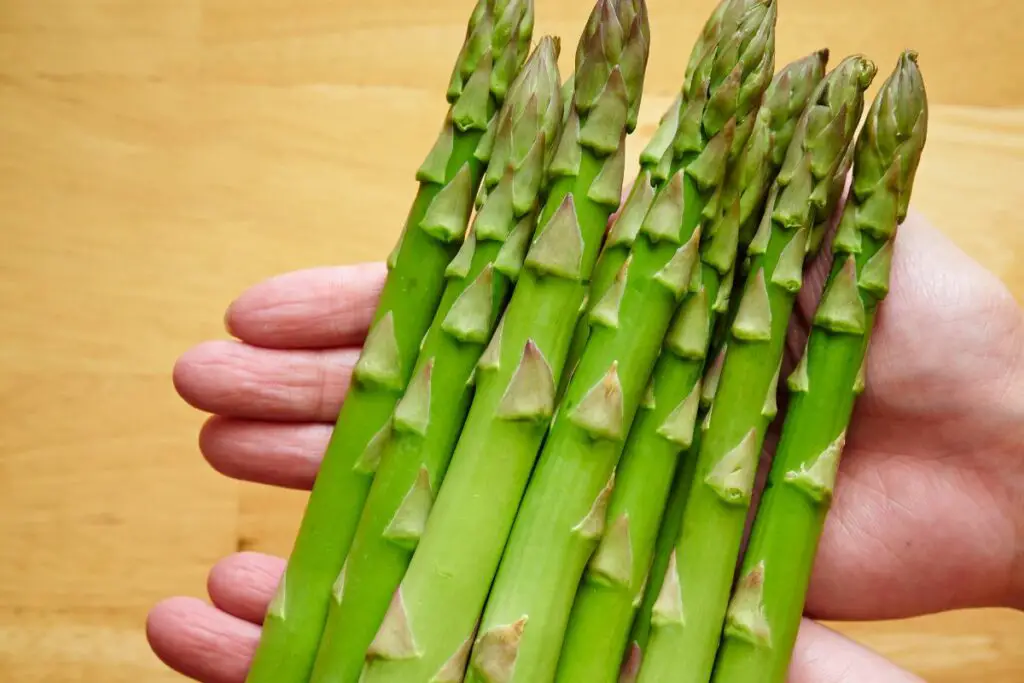
To check for the texture, hold the stalks in an upright position. If they are fresh, they will stay upright and firm and not bend or wilt. The tips of asparagus should be compact and closed.
Furthermore, the surface of the asparagus stalks should feel firm and relatively smooth when you run your fingers over them.
2. Look For A Bright Green Color
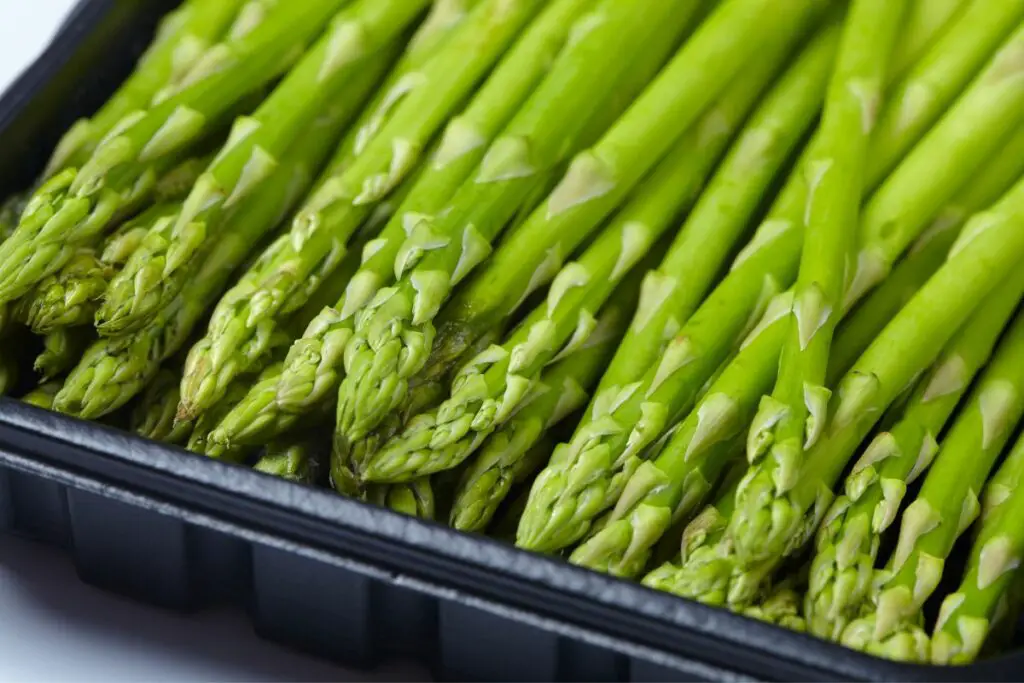
A bright dark green stem indicates that the asparagus is fresh. You will also notice that the color fades to white at the end. The asparagus can also have a green or purple hue on the tip, which is a good sign.
If there are signs of yellowish or blemish, it means that the asparagus is not that fresh and would probably not last long, even with careful storage.
You can follow the same guidelines for white or purple asparagus; i.e., the stem should be bright, and there shouldn’t be any stains.
3. Get The Same-Size Stalks
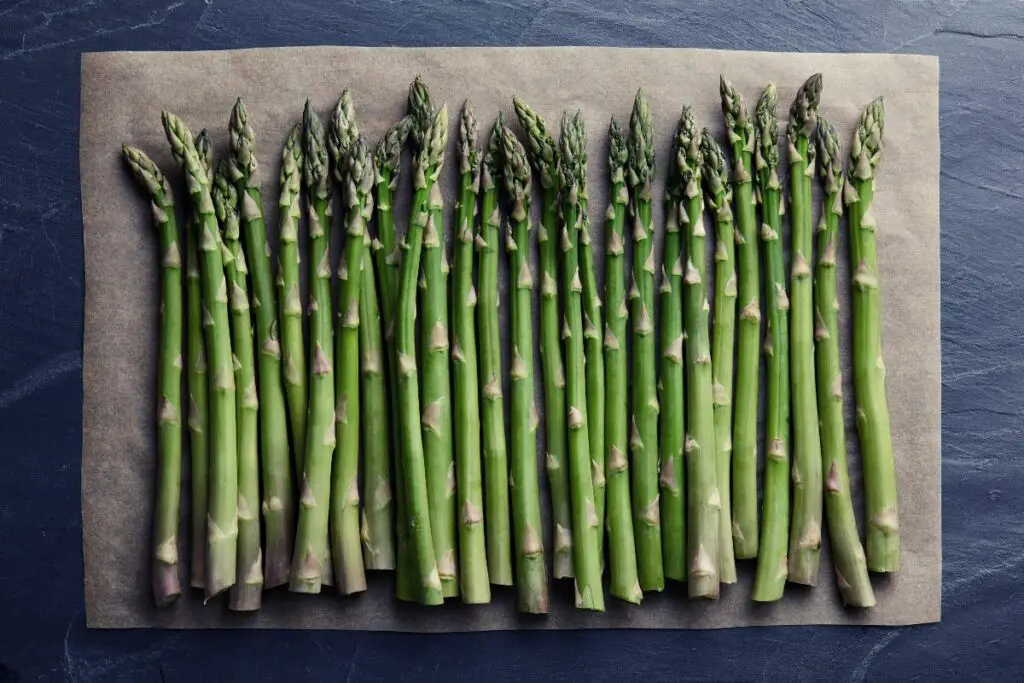
Look for stalks with consistent length and thickness. By the way, the size isn’t indicative of the plant’s freshness, but choosing uniform stems will make it easier to store and cook them.
Tender, thin asparagus spears can be steamed, sautéed, or lightly rubbed with olive oil or butter and grilled.
Thicker asparagus stalks can still turn out quite tender when broiled, grilled, blanched, or sautéed; it would just take a few minutes longer.
While the smaller spears are more tender and delicate, I personally enjoy the more robust flavor and meatier texture of the larger spears.
3. It Should Have Pointy Tips
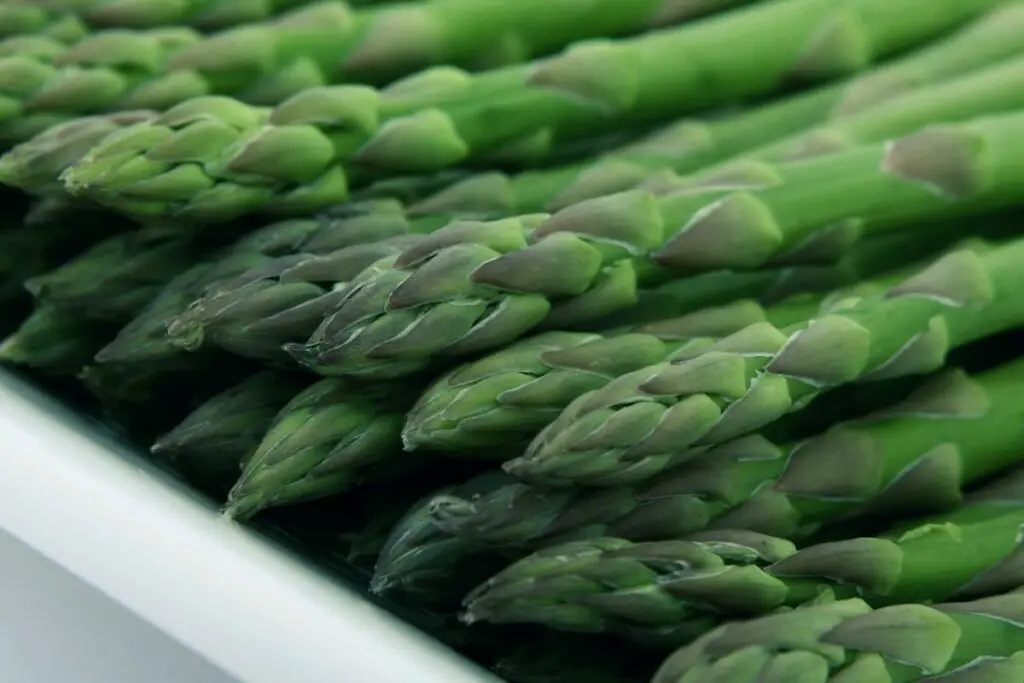
It is essential to ensure that fresh asparagus should have pointy tips or buds when selecting it. This is due to the fact that the pointy tips are indicative of a more recent harvest and, therefore, fresher produce.
The tip should be pointy and hard and tightly closed, not spreading like a flower. It shouldn’t be yellow or dry but purple, green, or white, depending on the variety.
Similarly, older asparagus tend to have a woody or cracked end. You have to look for firm and snappy bottoms.

Did You Know? Purple asparagus is not that different in flavor and texture from green asparagus. White asparagus is technically green asparagus grown without sunlight. Green asparagus is still considered to be the best in terms of nutrition. Green asparagus is somewhat grassy in flavor, while white asparagus is slightly bitter but mild. Purple asparagus is slightly sweeter and nuttier because of the higher level of sugar in its stalks.
How To Know When Asparagus Is Bad?

One of the primary indicators that asparagus has gone bad is a change in texture, as the stalks become limp and soft to the touch. Additionally, the discoloration can be another sign that asparagus has gone bad; green stalks may fade to yellow or brown, while white varieties may darken.
In addition, any visible signs of mold, slimy texture, black or brown spots, or foul smell means that asparagus has been damaged or already spoilt and shout not be eaten and should be thrown out!
Read Also: The 10 Most Eaten Vegetables In America (And Most Hated).
How To Store Fresh Asparagus?
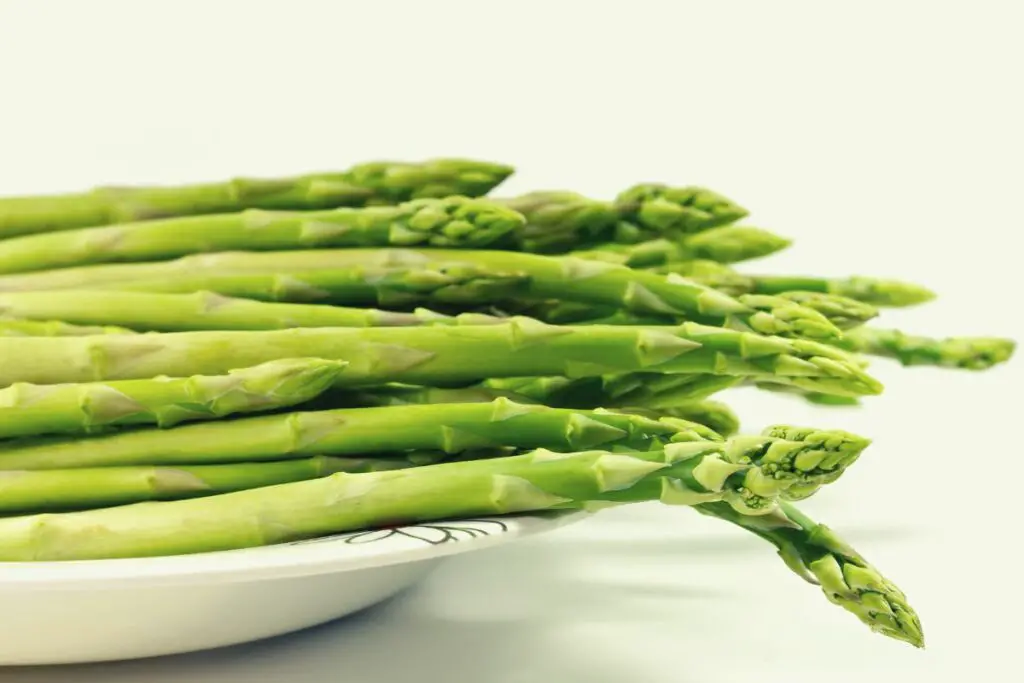
Fresh, store-bought asparagus has an optimal shelf life of approximately 3-5 days. Asparagus is a highly perishable vegetable and can easily spoil if not stored correctly; therefore, the longevity of fresh asparagus is heavily reliant on its storage conditions.
The best way to store fresh asparagus is in a refrigerator, and with some simple tricks, you can make it stay fresh for up to 5 days.
Here are the best ways you can keep your asparagus stalks firm and crispy:
1. Store It In a Refrigerator With a Damp Paper Towel
Refrigeration is the best method for preserving the quality and extending the lifespan of asparagus. When stored in a refrigerator, asparagus can remain fresh for up to 3 days, depending on the temperature and humidity levels in the environment.
To maximize longevity, it is recommended that you place unwashed asparagus spears in a bag with a damp paper towel before placing them in the refrigerator.
The Process
- Wrap the bunch of asparagus with a few sheets of damp paper towels and place them inside a breathable plastic bag.
- Put the plastic bag inside the vegetable compartment of your fridge.
- Check on them every day and remove the stalks that show signs of spoilage.
2. Store It In a Glass Jar In The Refrigerator
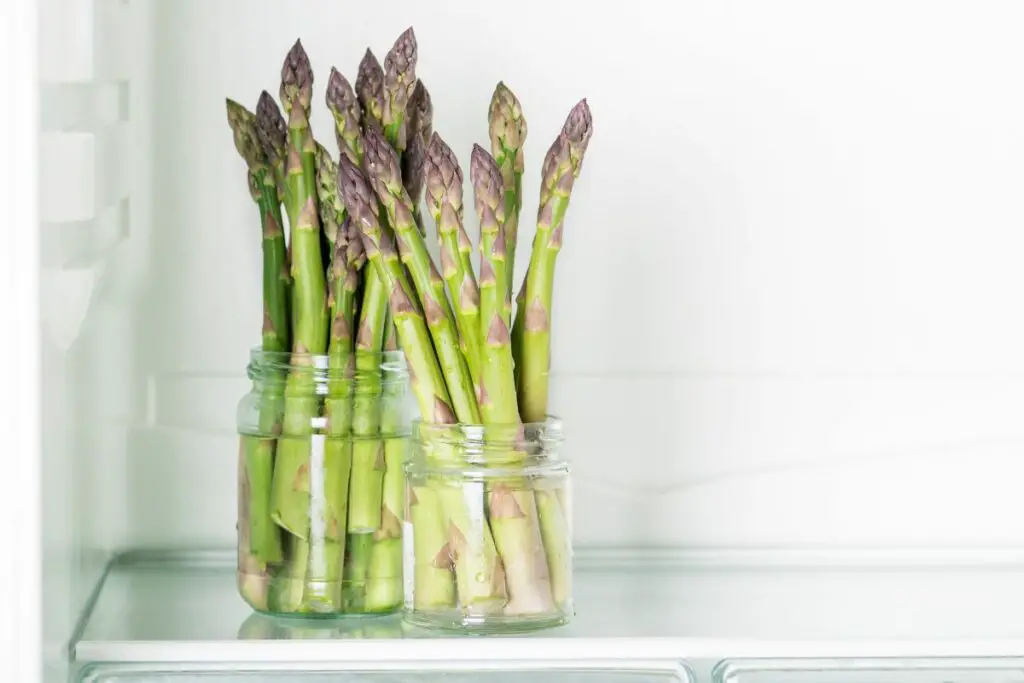
You can also store your asparagus in water in a glass jar like flowers and refrigerate it. Doing so will allow the vegetable to retain its freshness for up to five days.
Steps to Follow
- Tie the asparagus stalks together with a rubber band and trim an inch off their bottom with a sharp knife.
- Pour about an inch of fresh water into the glass jar.
- Remove the rubber band from the asparagus stems and put them in the jar with their bottom end immersed in the water. Ensure that they sit upright.
- Cover the jar and the asparagus spears with a clean plastic bag. Don’t forget to leave some room for air circulation.
- Put the jar inside the refrigerator.
- Keep an eye on the water every day and change it if it gets cloudy.
Can You Freeze Asparagus Raw?

Asparagus can indeed be frozen raw, and the process requires little more than blanching the spears briefly before freezing. Blanching is an essential step in preserving the flavor and texture of vegetables that are to be frozen, as it quickly cooks the exterior while still retaining a crisp inner consistency
How To Freeze Raw Asparagus:
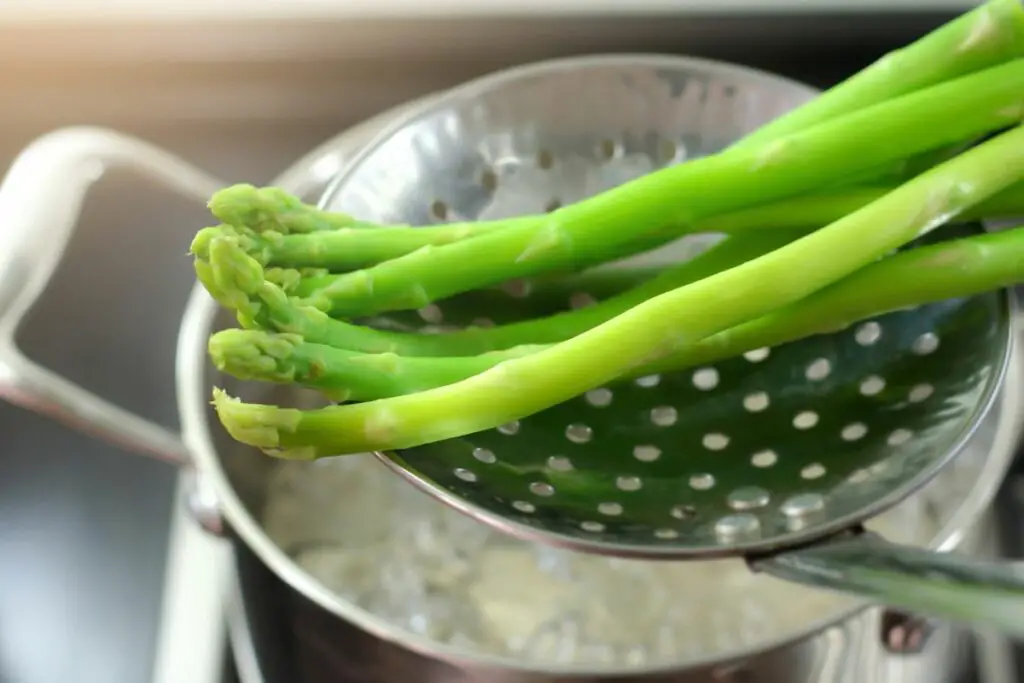
- Trim an and a half inch off the bottom of the stalks.
- Bring some water to a boil in a pot and put the asparagus into it.
- Blanch for between 90 to 180 seconds until the stems are bright green but not cooked.
- Using tongs or a slotted spoon, transfer the asparagus into cold water or an ice bath and let it stay there for a few minutes until cooled down.
- Remove the asparagus from the cold water and dry it with paper towels.
- Divide the asparagus stalks into appropriate portions and put them inside the freezer bags or containers, and put them in the freezer.
- Blanched and frozen asparagus will last for up to 6 to 8 months in the freezer.
Cooking Frozen Asparagus
When you freeze asparagus, it will turn out a little soft when cooked later. Thus, it’s a good idea to use them in soups, sauces, or casseroles where the crispiness doesn’t matter as much.
It is not necessary to thaw frozen asparagus before cooking it, as the process of defrosting is often unnecessary and can even lead to a decrease in the texture and flavor of the vegetable.
In Conclusion
Picking asparagus at the store and keeping it fresh is easy when you follow the tips I discussed in this article.
- First, make sure to check the appearance of the asparagus you’re buying for freshness.
- Second, store your asparagus in a damp paper towel and container or plastic bag.
- Third, keep your asparagus in the fridge to ensure it retains its crunchiness.
- Fourth, don’t forget to use a sharp knife when cutting off the woody ends.
You can also choose to blanch your asparagus for easy storage in the freezer for up to 8 months.
